This article is brought to you by Rx Green Technologies, helping cannabis growers get tough on pests and diseases.
Cannabis crops that aren’t protected from pests and diseases are susceptible to a variety of problems. Cannabis growers can be proactive about pests by putting strategies in place to keep them at bay.
The team at Rx Green Technologies are experts on comprehensive systems that help your crop grow to its maximum potential, while minimizing damage from pesky pests and diseases. Use their suggestions to help you reduce risk and avoid the troublesome consequences of an infected cannabis crop.

(Zenkyphoto/iStock)
1) Learn your cannabis pests and diseases, so you know how to spot them.
There’s a variety of insects and diseases that may decide to call your cannabis crop home. Rx Green Technologies advises growers to look out for the following:
- Powdery mildew
- Botrytis
- Hemp russet mites
- Broad mites
- Two-spotted spider mites
- Pythium
- Root aphids
- Whiteflies
- Thrips
- Fungus gnats
2) Tackle pest problems with a multi-faceted approach.
An integrated pest management (IPM) system is a well-rounded approach to get your pest issues under control. You can reduce the risk of pests and disease in your operations using cultural, mechanical, biological and chemical strategies.
3) Get preventative with your cannabis growing practices.

(OlegMalyshev/iStock)
It only takes a few spores or one particularly enthusiastic pest to start your crop on a downward spiral. Make sure that your grow rooms are sanitized regularly and make sure that you wear gloves when touching your plants. Wash your hands or change your gloves to prevent cross-contamination.
4) Apply pesticides to your cannabis crop regularly.
When you get in the habit of applying pesticides, pests can’t get in the habit of thriving off your plants. Prevent the build-up of unwanted populations with a solid pesticide application schedule based on the correct use rates. Make sure that you’re using your application equipment correctly and that you understand the life cycle of any pests you encounter, so you can apply pesticide at the most effective times.
5) Check plant material as it enters the facility.
Before you introduce any new plants to your grow, check them for pests and diseases in a separate, quarantined area. This will help you contain any problems that arise and keep them away from the rest of your carefully-tended cannabis crop.
6) Fight back with other bugs and bacteria.

(Courtesy of RxGreen)
Of course, there are some members of nature’s bounty that will actually help your cannabis crop. Introducing predatory mites or wasps that eat bad bugs are one way to protect your grow.
Other natural options include beneficial fungi and bacteria that will keep your crop in balance. Just remember not to kill your new flying or fungal friends with any chemical controls.
7) Measure and adjust the environment of your cannabis grow.
Mold and mildew love high humidity, so you should keep an eye on the moisture levels in your facility. Temperatures that are too warm are also conducive to a variety of pests. To be safe, keep an eye on temperatures and air moisture levels at all times.
You should also avoid reusing your growing media, preventing any vexing leftover enemies from capitalizing on your new crop.
8) Make a commitment to cannabis growing best practices.
Cannabis growers already familiar with best practices should never let up. Always remove old or unhealthy-looking leaves or completely cull sick plants. Remove any infested cannabis plants from the rest of your crop entirely.
Lastly, always keep your eyes peeled for pests that are ready to roll out the welcome mat to their friends. Pests love a party and serve as excellent disease vectors, so take precaution.
Continue to stay vigilant about your cannabis crop, and be ready to act as soon as you see a problem.







